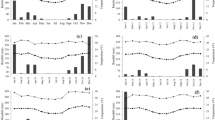Summary
The results of adaptability trials carried out on 43 species ofEucalyptus in two different environments viz., Jodhpur and Pali are discussed. It was observed that the species with wide latitudinal distribution and belonging to summer rainfall regions in their native habitat have done well compared to the species with narrow latitudinal distribution and belonging to winter rainfall areas. In general,Eucalyptus melanaphloia, E. terminalis andE. camaldulensis proved to be the most promising species and are recommended for large-scale species elimination trials in the region. However, for the region like Pali having calcareous soils,E. tessellaris should be preferred over other species as it has shown the best performance. The differential growth and development exhibited by different species in the two habitats suggest a need for studying the correct mycorrhizal fungus in the establishment and growth of the species.
Similar content being viewed by others
References
Blatter, E. - 1927–28 - Flowering season and climate,J. Bombay Nat. Hist. Soc., 17,334 and692.
Kaul, R. N. &Jain, M. B. - 1967 - On the selection of suitable exotic tree species for Indian arid zones.I. Eucalyptus Proc. XIV IUFRO-Conf. Munich. (In press).
Author information
Authors and Affiliations
Additional information
with 1 fig.
Rights and permissions
About this article
Cite this article
Kaul, R.N., Jain, M.B. & Chand, G. Performance of eucalyptus in the Indian arid zone. Plant Food Hum Nutr 17, 131–147 (1969). https://doi.org/10.1007/BF01100628
Published:
Issue Date:
DOI: https://doi.org/10.1007/BF01100628




